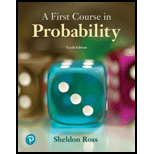
Concept explainers
The strong law of large numbers states that with probability 1, the successive arithmetic averages of a sequence of independent and identically distributed random variables converge to their common
Want to see the full answer?
Check out a sample textbook solution
Chapter 8 Solutions
EBK FIRST COURSE IN PROBABILITY, A
- marks 11 3 3/4 x 1/4 1. There are 4 balls in an urn, of which 3 balls are white and 1 ball is black. You do the following: draw a ball from the urn at random, note its colour, do not return the ball to the urn; draw a second ball, note its colour, return the ball to the urn; finally draw a third ball and note its colour. (i) Describe the corresponding discrete probability space (Q, F, P). [9 Marks] (ii) Consider the following event, A: Among the first and the third balls, one ball is white, the other is black. Write down A as a subset of the sample space and find its probability, P(A). [2 Marks]arrow_forwardThere are 4 balls in an urn, of which 3 balls are white and 1 ball isblack. You do the following:• draw a ball from the urn at random, note its colour, do not return theball to the urn;• draw a second ball, note its colour, return the ball to the urn;• finally draw a third ball and note its colour.(i) Describe the corresponding discrete probability space(Ω, F, P). [9 Marks](ii) Consider the following event,A: Among the first and the third balls, one ball is white, the other is black.Write down A as a subset of the sample space Ω and find its probability, P(A)arrow_forwardLet (Ω, F, P) be a probability space and let X : Ω → R be a randomvariable whose probability density function is given by f(x) = 12 |x|e−|x| forx ∈ R.(i) Find the characteristic function of the random variable X.[8 Marks](ii) Using the result of (i), calculate the first two moments of therandom variable X, i.e., E(Xn) for n = 1, 2. [6 Marks]Total marks 16 (iii) What is the variance of X?arrow_forward
- ball is drawn from one of three urns depending on the outcomeof a roll of a dice. If the dice shows a 1, a ball is drawn from Urn I, whichcontains 2 black balls and 3 white balls. If the dice shows a 2 or 3, a ballis drawn from Urn II, which contains 1 black ball and 3 white balls. Ifthe dice shows a 4, 5, or 6, a ball is drawn from Urn III, which contains1 black ball and 2 white balls. (i) What is the probability to draw a black ball? [7 Marks]Hint. Use the partition rule.(ii) Assume that a black ball is drawn. What is the probabilitythat it came from Urn I? [4 Marks]Total marks 11 Hint. Use Bayes’ rulearrow_forwardLet X be a random variable taking values in (0,∞) with proba-bility density functionfX(u) = 5e^−5u, u > 0.Let Y = X2 Total marks 8 . Find the probability density function of Y .arrow_forwardLet P be the standard normal distribution, i.e., P is the proba-bility measure on R, B(R) given bydP(x) = 1√2πe− x2/2dx.Consider the random variablesfn(x) = (1 + x2) 1/ne^(x^2/n+2) x ∈ R, n ∈ N.Using the dominated convergence theorem, prove that the limitlimn→∞E(fn)exists and find itarrow_forward
- 13) Consider the checkerboard arrangement shown below. Assume that the red checker can move diagonally upward, one square at a time, on the white squares. It may not enter a square if occupied by another checker, but may jump over it. How many routes are there for the red checker to the top of the board?arrow_forward12) The prime factors of 1365 are 3, 5, 7 and 13. Determine the total number of divisors of 1365.arrow_forward11) What is the sum of numbers in row #8 of Pascal's Triangle?arrow_forward
- Algebra & Trigonometry with Analytic GeometryAlgebraISBN:9781133382119Author:SwokowskiPublisher:Cengage
 Glencoe Algebra 1, Student Edition, 9780079039897...AlgebraISBN:9780079039897Author:CarterPublisher:McGraw Hill
Glencoe Algebra 1, Student Edition, 9780079039897...AlgebraISBN:9780079039897Author:CarterPublisher:McGraw Hill College Algebra (MindTap Course List)AlgebraISBN:9781305652231Author:R. David Gustafson, Jeff HughesPublisher:Cengage Learning
College Algebra (MindTap Course List)AlgebraISBN:9781305652231Author:R. David Gustafson, Jeff HughesPublisher:Cengage Learning  Algebra and Trigonometry (MindTap Course List)AlgebraISBN:9781305071742Author:James Stewart, Lothar Redlin, Saleem WatsonPublisher:Cengage Learning
Algebra and Trigonometry (MindTap Course List)AlgebraISBN:9781305071742Author:James Stewart, Lothar Redlin, Saleem WatsonPublisher:Cengage Learning



